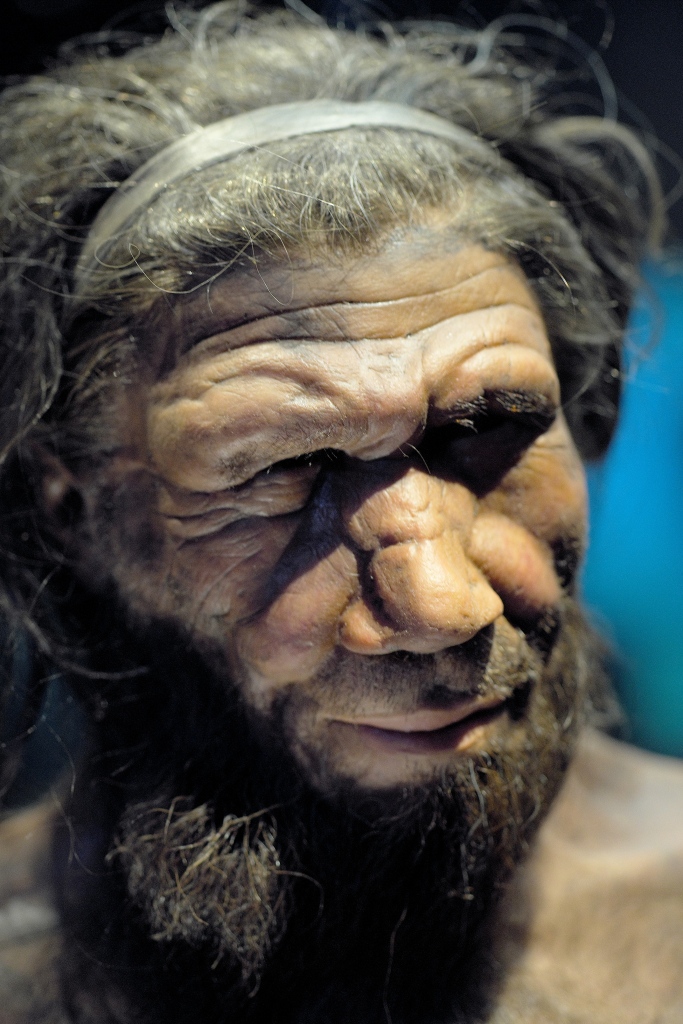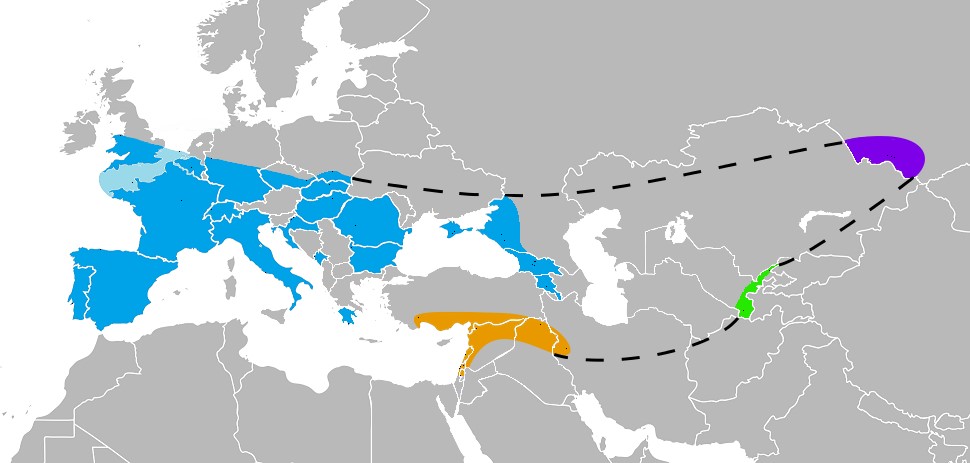Super fact 27: Neanderthals never lived in Africa. Neanderthals, or Homo Neanderthalensis, lived in Europe and Asia but never in Africa.

It is a common belief that humans originated in Africa. That is true but human ancestry is complicated, and in the past, there were many human species and subspecies. Starting with Homo Erectus, it is estimated that they lived between 1.6 million years ago until about 100,000 years ago.
Homo Erectus was the ancestor of Homo Heidelbergensis (between 700,000 and 200,000 years ago) as well as Homo Floresiensis (hobbit people – between 100,000 and 50,000 years ago). Homo Heidelbergensis in turn was the ancestor of (at least) three homo species, Homo Sapiens (between 300,000 until now), Homo Neanderthalensis (between 400,000 to 40,000 years ago), and Homo Denisova 300,000 to 25,000 years ago.
However, note that Homo Neanderthalensis is not an ancestor of Homo Sapiens. Homo Heidelbergensis was an ancestor to both. Homo Neanderthalensis originated in Europe and Asia and stayed there, whilst Homo Sapiens originated in Africa and ventured elsewhere (see picture below).
Homo Neanderthalensis and Homo Sapiens (or Homo Sapiens Sapiens) interbred, and so did Homo Denisova and Homo Sapiens, and Homo Neanderthalensis interbred with Homo Denisova. What a mess! I can add that Homo Neanderthalensis and Homo Sapiens were different species, so it may seem strange that they could interbreed.
However, species is a complex concept and at certain points in history you could consider Homo Neanderthalensis and Homo Sapiens to be different subspecies rather than different species. That is why you sometimes hear the terms Homo Sapiens Neanderthalensis and Homo Sapiens Sapiens. Now when you know how complicated it is, I suggest you take a look at the map below.

I can add that genetic testing can reveal how much Neanderthal DNA you have. I took a test with 23AndMe to find out about my ancestry (it was 98% Scandinavian and Finnish) and to find out about my risk for genetic illnesses. 23AndMe also told me that I was in the 99 percentiles with respect to carrying Neanderthal genes, meaning that I had unusually many Neanderthal genes (but not 99%). However, no one has called me a Neanderthal to my face yet.
The Extent of the Neanderthal Habitat
The map below indicates where skeleton remains of Neanderthals had been found as of 2017.

Other Neanderthal Facts
There are a lot of other interesting and surprising facts about Neanderthals, such as:
- They lived in caves, but they also built shelters.
- They had complex tools and skills, cooked and processed food and created art and jewelry, cooked glue, and had musical instruments (for example a bone flute).
- Neanderthals not only used fire, they were able to control and maintain fire, and they used it to cook food, make tools, and for warmth and shelter.
- Neanderthals were stockier and more muscular than modern humans, with broader rib cages and shorter limbs. This helped them conserve heat and survive in the cold environments in Europe and Asia during the ice ages.
- They might have spoken language.
- There’s evidence that they were seafaring as far back as 200,000 to 150,000 years ago.
- Their brains were larger than ours. The braincases of Neanderthal men and women averaged about 1,600 cm3 and 1,300 cm3, respectively, which is considerably larger than the modern human average (1,260 cm3 and 1,130 cm3, respectively).
- They had medical knowledge. They had knowledge of medicinal plants and well-healed fractures on many bones indicate the setting of splints. They also knew how to treat wounds.
- They hunted big game.
- They interbred with modern humans.
The Cause of the Ice Ages
Regarding the Ice Ages, which were a great challenge to Neanderthals, they are caused by earth’s orbital cycles. However, keep in mind that does not mean that orbital cycles are causing the current rapid global warming. NASA keeps track of the orbital cycles, and they should slowly be causing a cool down right now, not a rapid warming. In addition, if the warming was caused by orbital cycles (or the sun), the upper troposphere would be warming as well as the lower troposphere.
However, what we are seeing is a warming of the lower troposphere and cooling of the upper troposphere consistent with greenhouse gas emissions causing the warming (the blanket effect). To read more about what is causing the current global warming, click here.

Above from PBS explanation and overview of earth’s three orbital cycles.
Endangered Species
When I was a teenager, I read a few of Jean M. Auels novels about pre-historic humans. I loved them and I saw the movie. Now I am reading Jacqui Murray’s novels about pre-historic humans. Jacqui Murray’s books are even more fascinating and very realistic and well researched.
The latest Jacqui Murray book I’ve read is Endangered Species, the first book in her new series Savage Lands. This book is set to take place 75,000 years ago among Neanderthals and ancient Homo sapiens. I love all her books, but especially Endangered Species. I was also happy that she included canines as heroes in the book (Ump, White Streak, etc.) I am a dog lover after all. I can add that at the end of the book there are a lot of interesting Neanderthal Facts.
You can read my Amazon review for Endangered Species by clicking here and you can read my Virtual Book Blast post for Endangered Species (promoting this book) by clicking here. All the Virtual Book Blasts for Endangered Species feature interesting Neanderthal facts. To see a few more Virtual Book Blasts for this book click on the links in the list below.
- Virtual Book Blast for Endangered Species – Darlene Foster – Click here
- Virtual Book Blast for Endangered Species – Liz Gauffreau – Click here
- Virtual Book Blast for Endangered Species – Carol Cooks – Click here
- Virtual Book Blast for Endangered Species – John Howell – Click here
- Virtual Book Blast for Endangered Species – Booomcha, Kymber Hawke – Click here



The Endangered species books look so interesting.
LikeLiked by 1 person
Yes I think it is a very good book and brings you into the life and times of the Neanderthals
LikeLiked by 1 person
So interesting. And some people could have Neanderthal DNA today, but not Africans lol
LikeLiked by 1 person
Yes Neanderthal DNA is common in Europeans, especially in Scandinavians, but much rarer in Africans. According to 23And Me I have a lot of DNA genes and considering your Danish ancestry you may too.
LikeLiked by 1 person
That could be! lol I am so tall and thin though, so at least it’s not my phenotype. ;P
LikeLiked by 1 person
LOL Yes I would not think so. I don’t think the hox genes (for body plans) is what the Neanderthals passed down.
LikeLiked by 1 person
I find the lives of our ancestors most fascinating ..especially the Neatherthals can’t wait to read Jacquis book I’m waiting for Badlands so I can read one after the other 🙂
LikeLiked by 1 person
It is a great reading experience. I know you will love it.
LikeLiked by 1 person
Cool post, Thomas! I learned something new today…..
LikeLiked by 1 person
Thank you so much Alex.
LikeLiked by 1 person
Any timw, Thomas! 🙂
LikeLiked by 1 person
That should have been “Any time, Thomas!”
Sorry!
LikeLiked by 1 person
Thank you Alex I understood
LikeLike
This might be your best Super Fact ever (but I’m biased!). You really did your research.
LikeLiked by 1 person
Thank you so much Jacqui. Coming from you that means a lot. One aspect I love about your books is your thorough research and I loved the end section with all the Neanderthal facts.
LikeLiked by 1 person
Hi Thomas, this is a most interesting topic and I enjoyed your commentary very much. I have also researched this subject and, like you, I read Jean Auel as a youngster. A lovely shout out for Jacqui’s books too.
LikeLiked by 1 person
Thank you so much Robbie. I agree it is a very interesting topic.
LikeLike
What a great post, Thomas. According to 23andMe, I’ve ~2 percent Neanderthal DNA, with 285 variants that trace back to them. Fascinating information. Like you, I’m in awe of Jacqui’s research and her books. Thank you for sharing today!
LikeLiked by 1 person
Yes that’s the uniquely, or almost uniquely Neanderthal, subset of the DNA that they are talking about. There’s also the genes that Homo Sapiens and Neanderthals commonly share, but that is a lot more of that for everyone. Why they separate those genes out is because they indicate interbreeding in the past. There are a lot of genes that Homo Sapiens and Neanderthals shared before any interbreeding happened. Regarding that almost uniquely Neanderthal DNA, mine was 3 something percent which was rare enough to put me in the 99 percentile. Anyway, thank you so much for your kind comment Gwen and I am also in awe of Jacqui’s research.
LikeLiked by 1 person
Neanderthals are fascinating! Thank you for sharing this information.
LikeLiked by 2 people
Yes I agree. Thank you very much Dawn.
LikeLike
Always interesting facts here Thomas. How amazing you have Neanderthal DNA. A nice mention of Jacqui’s books too. 🙂
LikeLiked by 1 person
Thank you so much Debby. You find out about things like Neanderthal DNA from companies like 23AndMe. Originally I wanted to find out about origins, possible unknown relatives and inherited diseases. The latter information is not something you want to give to insurance companies, something I did not think about at the time. Since I originally got this information from Jacqui’s book (then I looked up at more sites) I thought I give her book a shout out.
LikeLiked by 1 person
Thanks again for sharing. And yes, too much information for eyes and ears everywhere isn’t good. 🙂
LikeLiked by 1 person
Thanks for this interesting look at the Neanderthals. It’s been fascinating in recent years to learn that many of us are descended from them.
LikeLiked by 1 person
I agree it is a fascinating topic. Thank you David.
LikeLiked by 1 person
Sometimes I wonder what the world would be like if more than homo sapiens had survived … but given how we homo sapiens treat each other, I can’t imagine it would have worked out well trying to share the world with a different species. Sigh.
LikeLiked by 1 person
Those are some interesting thoughts. I think you are right. Homo Sapiens, Homo Denisova, Homo Neanderthalensis and Homo Floresiensis co-existed for a long time, but I think co-existence would have been increasingly difficult.
LikeLike
Fascinating on the map showing the spead of Neanderthals how they lived just below the ice cap, and how Scotland and most of Germany (to point out the least) were still under ice.
LikeLiked by 1 person
Yes I agree, it is quite interesting information. Thank you so much Patricia.
LikeLiked by 1 person